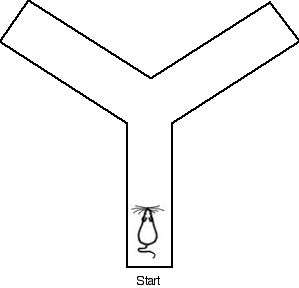Credit: ratbehavior.org
(Medical Xpress)—At the same settings and light conditions, a camera will take the same picture every time. In contrast, a brain does not make perfect reconstructions of a stimulus. It appears instead to accumulate evidence over time, which it then fits to an evolving internal model. A group of Princeton researchers has sought to explain some aspects of how rats and humans might accumulate evidence in an experimental decision-making task. Publishing recently in Science, they present a method which they claim can reveal internal properties of the decision processes in the absence of any details about how that accumulator works. They further conclude that the accumulator, the memory of the rat or human subject, operates with zero noise.
In information theory noise has a precise definition. For digital systems, Claude Shannon's noisy-channel coding theorem, shows that error-free communication is possible up to a computable maximum rate. Similarly, for analog systems, the noise in a known transmission channel is found simply by subtracting the received signal from the original signal—assuming you know what that original signal is.
In a brain, the concept of noise is not as clear cut. Computational neuroscientists regularly create models of sensory processing in which they assign noise levels to the spike trains produced in response to a stimulus. Another Princeton researcher, William Bialek, perhaps the foremost researcher in the field, summarized these techniques in his groundbreaking work, Spikes, Exploring the Neural Code.
In this new research statistical model are developed to set criteria on how accumulator networks might arrive at a decision in the presence of noise in a sensory stimulus. The task used is to present random clicks trains simultaneously to the left side and the right side of the subject. The clicks are distributed according to Poisson statistics, with a maximum rate of around 40 hz in order that they can be be perceived discretely, rather than as a low frequency tone. The subject then must determine which side had more clicks in each stimulus train. In each trial, the total number of clicks is preserved, only their distribution in each trial changes. As expected, performance improved as the difference between the number of clicks presented to each side was increased, and also as the number of trials was increased.
Learn about research on decision-making in this podcast with Carlos Brody, an associate professor of molecular biology affiliated with the Princeton Neuroscience Institute and a Howard Hughes Medical Institute Investigator. Credit: Princeton University
The idea underlying these experiments, is that by tracking performance improvement at each trial, along with the microstructure of the click train, the researchers can eliminate different models of how the accumulator network actually does its job. The dense details of the actual models used were presented previously in thesis form by the lead author on the paper. The champion model was dubbed, the Click Accumulator model, and reportedly demonstrates the zero noise decision-making effect. Other models presented in the paper, the burst detector and the precedence detector, looked at local features of the stimulus train, and whether one side tended to precede the other.
To fully absorb and vet these methods would probably take even a fairly skilled reader about as much time as it took the author to write them in the thesis. That makes it tough to take on faith the idea of being able to make conclusive statements regarding what a black-boxed brain must be doing, without even looking at its activity. It is nice to know that we can perform some tasks optimally and with no internal noise despite ample noise in the stimulus, but the question of how, still remains.
A similar situation arises in even more complicated tasks, like for example, how do some savants near-instantaneously determine the primacy of numbers? One might eliminate all known methods of determining prime numbers, but it is hard to eliminate the possibility that the savant is not using some other as-yet unknown method. In this case it is also hard to fully eliminate the trivial scenario in which the savant just memorized the properties of all the primes under consideration.
In the original thesis, efforts were begun to look at the underlying mechanisms behind this evidence accumulation process. Collaboration with cutting-edge labs, like that of Karl Deisseroth, to use optogenetic probes in individual neurons have gotten underway. The idea of postulating mechanisms that the neuron networks might in fact be using, is still a very powerful technique. For example, in trying to read a road sign or a face in crowd, does our visual system fill in details slowly like a puzzle over time, or might it instead prefer to wipe the slate clean so to speak, every second and start to gather information anew? Combining these theoretical models with actual neuron data will help bring greater understanding to this area of psychology.
More information: Rats and Humans Can Optimally Accumulate Evidence for Decision-Making, Science 5 April 2013: Vol. 340 no. 6128 pp. 95-98 DOI: 10.1126/science.1233912
ABSTRACT
The gradual and noisy accumulation of evidence is a fundamental component of decision-making, with noise playing a key role as the source of variability and errors. However, the origins of this noise have never been determined. We developed decision-making tasks in which sensory evidence is delivered in randomly timed pulses, and analyzed the resulting data with models that use the richly detailed information of each trial's pulse timing to distinguish between different decision-making mechanisms. This analysis allowed measurement of the magnitude of noise in the accumulator's memory, separately from noise associated with incoming sensory evidence. In our tasks, the accumulator's memory was noiseless, for both rats and humans. In contrast, the addition of new sensory evidence was the primary source of variability. We suggest our task and modeling approach as a powerful method for revealing internal properties of decision-making processes.
Journal information: Science
© 2013 Medical Xpress




















